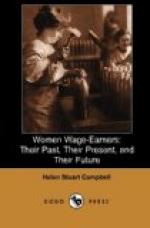On this pittance they lived as they could. Sand did duty as carpet for the floor. The cupboard knew no china, and the table no glass. Coal and matches were unknown; they had never seen a stove. The meals of coarsest food were eaten from wooden or pewter dishes. Fresh meat was seldom eaten more than once a week. A pound of salt pork was tenpence, and corn three shillings a bushel. Clothing was as coarse as the food, and imprisonment for the slightest debt was the shadow hanging over every family where illness or any other cause had hindered earning. Boys and girls in the poorer families were employed by the owners of cattle to watch and keep them within bounds, countless troubles arising from their roaming over the unfenced fields. Andover, Mass., being from the beginning of a thrifty turn of mind, passed, soon after the founding of the town, an ordinance which still stands on the town records:—
“The Court did herupon order and decree that in every towne the chosen men are to take care of such as are sett to keep cattle, that they may be sett to some other employment withall, as spinning upon the rock, knitting and weaving tape, &c.”
Spinning-classes were also formed; the General Court of Massachusetts ordering these in 1656, this being part of the general effort to begin some form of manufactures. But fishing to load ships, and shipbuilding to carry cured fish absorbed the energies of the growing population; and these vessels brought textiles and manufactured goods from the cheapest markets everywhere and anywhere.[5]
These “homespun” industries soon showed a tendency toward division. By 1669 much weaving was done outside the home as custom work; and there is record of one Gabriel Harris who died in 1684 leaving four looms and tacklings and a silk loom as part of the small fortune he had accumulated in this way.[6] His six children and some hired women assisted in the work. In 1685 Joseph, the son of Roger Williams, entered in an account book now extant,[7] a credit to “Sarah badkuk [Babcock], for weven and coaming wisted.” This work was, however, chiefly in the hands of men.
The records of Pepperell, Mass., show that many women saved their pin money, and sent out little ventures in the ships built at home and sailing to all ports with fish. These ventures included articles of clothing, embroideries, and anything that it seemed might be made to yield some return. There were also women of affairs, some of whom took charge of large industries. Thus Weeden, in his “Economic and Social History of New England,” quotes from an interesting memorandum left by Madam Martha Smith, a widow of St. George’s Manor, Long Island,[8] which shows her practical ability. In January, 1707, “my company” killed a yearling whale, and made twenty-seven barrels of oil. The record gives her success for the year, and the tax she paid to the authorities at New York,—fifteen pounds and fifteen shillings, a twentieth part of her year’s gains.




